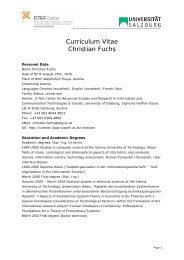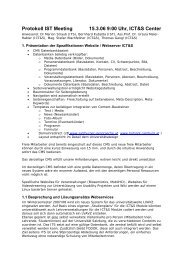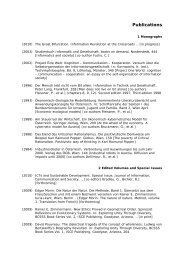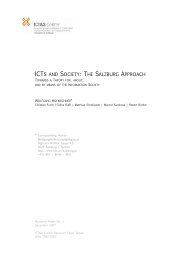CHRISTIAN FUCHS - ICT&S - Universität Salzburg
CHRISTIAN FUCHS - ICT&S - Universität Salzburg
CHRISTIAN FUCHS - ICT&S - Universität Salzburg
Create successful ePaper yourself
Turn your PDF publications into a flip-book with our unique Google optimized e-Paper software.
Christian Fuchs: Social Networking Sites and the Surveillance Society10. ReferencesAcquisti, Alessandro and Ralph Gross. 2006. Imagined communities: Awareness,information sharing, and privacy on the Facebook. In Proceedings of 6th Workshopon Privacy Enhancing Technologies, ed. by Phillipe Golle and George Danezis, 36-58. Cambridge, UK: Robinson College.Albrechtslund, Anders. (2008). Online Social Networking as Participatory Surveillance.First Monday 13 (3).Alby, Tom. 2007. Web 2.0. Konzepte, Anwendungen, Technologien. München: Hanser.Baker, James R. and Susan M. Moore. 2008. Distress, coping, and blogging: Comparingnew Myspace users by their intention to blog. CyberPsychology & Behavior 11 (1):81-85.Ball, Kirstie S, and Frank Webster, eds. 2003. The intensification of surveillance. Crime,terrorism and warfare in the information age. London: Pluto Press.Barabási, Albert-László. 2003. Linked. New York: Plume.Barnes, Susan. (2006). A privacy paradox: Social networking in the United States. FirstMonday 11 (9).Baym, Nancy. 2007. The new shape of online community: The example of Swedishindependent music fandom. First Monday 12 (8).Beer, David. 2006. The pop-pickers have picked decentralised media: The fall of top ofthe pops and the rise of the second media age. Sociological Research Online 11 (3).Beer, David. 2008a. Making friends with Jarvis Cocker: Music culture in the context ofWeb 2.0. Cultural Sociology 2 (2): 222-241.Beer, David. 2008b. Social network(ing) sites revisiting the story so far: A response todanah boyd & Nicole Ellison. Journal of Computer-Mediated Communication 13 (2):516-529.Bernardo, Theresa A. 2007. Harnessing collective knowledge to create global publicgoods for education and health. Journal of Veterinary Medical Education 34 (3): 330-334.Bogard, William. 2006. Surveillance Assemblages and Lines of Flight. In TheorizingSurveillance, edited by David Lyon, 97-122. Cullompton: Willan.boyd, danah. 2004. Friendster and publicly articulated social networks. In Proceedingsof ACM Conference on Human Factors in Computing Systems, 1279-1282. NewYork: ACM Press.boyd, danah. 2005. Why web 2.0 matters: Preparing for glocalization.http://www.zephoria.org/thoughts/archives/2005/09/05/why_web20_matte.html(Accessed on July 9, 2007).boyd, danah 2006a. Friends, Friendsters, and MySpace Top 8: Writing community intobeing on social network sites. First Monday 11 (12).boyd, danah. 2006b. Identity production in a networked culture: Why youth heartMySpace. Talk at AAAS 2006 (part of panel: "It's 10PM: Do You Know Where YourChildren Are ... Online!"). St. Louis, Missouri: February 19, 2006.boyd, danah. 2007a. The significance of social software. In BlogTalks reloaded, editedby Thomas N. Burg, 15-30. Norderstedt: Books on Demand.boyd, danah. 2007b. Viewing American class divisions through Facebook andMySpace. Apophenia Blog Essay. June 24.http://www.danah.org/papers/essays/ClassDivisions.htmlboyd, danah. 2008a. Facebook’s privacy trainwreck. Convergence 14 (1): 13-20.boyd, danah. 2008b. Why youth (heart) social network sites: The role of networked118









